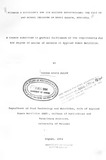Vitamin A Deficiency And Its Dietary Associations: The Case Of Pre-School Children In Arssi Region, Ethiopia
Abstract
Vitamin A deficiency and xerophthalmia is a well identified public health problem among pre-school children in the southern part of rural Ethiopia, Arssi region. This has been associated with the low frequency of consumption of vitamin A rich foods and a variety of interfering food habits and beliefs.
A cross sectional study was carried out in two rural villages of Arssi region in Southern Ethiopia in the period between January - March 1993. The objective of this study was to determine the severity of vitamin A deficiency and its dietary associations among pre-school children. For the purpose of this study, two clusters of villages in a rural setting were randomly selected. The total number of households included in the study was 130, of which 54 households were from village Hate tulu and 66 households from village Andode. A total of 229 children under five years of age were examined and clinical diagnosis conducted. A questionnaire on food frequency, breastfeeding and weaning and food habits and beliefs was administered in all the households.
Out of 229 children examined, 33 had at least one recognizable
I
sign of vitamin A deficiency giving an overall vitamin A deficiency and xerophthalmia prevalence 14.4 percent.
xix
The prevalence of night blindness and Bitot's spots was reported to be 11.4% and 0.9% respectively. Corneal xerosis, corneal ulceration and corneal scars were reported to be 0.9%, 0.43% and
0.43% respectively. These figures are above WHO's criteria which shows evidence for a public health problem. Most of these cases were in the age group of 48-60 months. More boys 61% were affected as compared to girls 39%.
The number of households that consumed locally available vitamin A rich foods at least 3 times a week is below 75% which, according to IVACG's criteria, suggests inadequate intake. This low frequency of consumption of vitamin A rich foods was also significantly associated (p<0.0001) with the occurrence of xerophthalmia.
A shorter period of breastfeeding was highly associated (p<0.01) with the deficiency state in the children. The weaning period and type of weaning food given contributes to vitamin A intake. However, most of the younger children in the study area, were not encouraged to eat dark green leafy vegetables nor animal products. Furthermore, the majority of the mothers weaned their children late. The data suggests that the age when foods were introduced has a significant association (p<0.0001) with xerophthalmia.
Publisher
University of Nairobi

